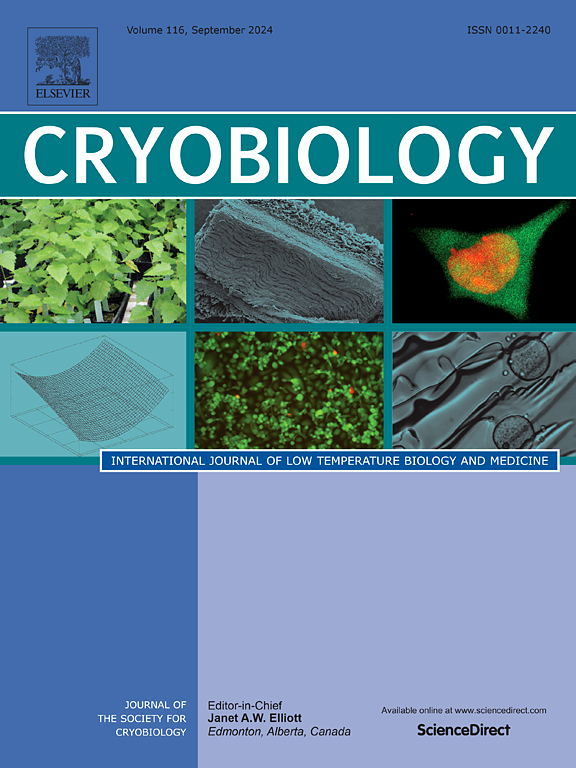Studies on ovarian tissues’ cryopreservation in the cyprinid species
IF 2.3
3区 生物学
Q2 BIOLOGY
引用次数: 0
Abstract
This study was aimed to establish an effective protocol to cryopreserve the ovarian tissues of cyprinid species, including the crucian carp (Carassius auratus), zebrafish (Danio rerio) and Ya fish (Schizothorax prenanti), crucian carp was used to establish an efficient method of ovarian cryopreservation, zebrafish and Ya fish were used to validate this method. In addition, oxidative stress-related injuries induced by cryopreservation was determined in Ya fish, and the cryopreservation method was modified by adding tea polyphenol (TP) into the cryomedium. First, based on the cellular plasma membrane integrity analysis of the frozen-thawed ovarian tissues, the cryomedium and dehydration/rehydration procedures were intensively evaluated and optimized in the crucian carp. The result showed that the highest cell membrane integrity of cryopreserved ovaries was up to 51.67 ± 0.78 % (including somatic cells and oogonia) after a 7-day cryopreservation under the optimized protocol (the cryomedium containing 10 % FBS, 10 % DMSO, 6 % sucrose, and 6 % BSA in 1xPBS), together with gradient dehydration and rehydration procedures. This protocol was applied to cryopreserve ovaries in another two cyprinid species: in Ya fish, cell membrane integrity of frozen-thawed ovaries was ∼65.12 %, and in zebrafish, it was ∼44.56 %. Moreover, the frozen-thawed ovaries of both two fish species could be used for in vitro culture. Secondly, it was found that the cryopreservation significantly caused oxidative stress (increasing the levels of oxidation index MDA and antioxidant enzymes SOD and CAT) in the frozen-thawed ovaries of Ya fish. Intriguingly, an antioxidant, the TP supplemented into the cryomedium could prominently improve the cells' membrane integrity of frozen-thawed ovaries to 73.82 ± 4.89 %. Likewise, tea polyphenol could also enhance cells’ proliferation potency of the cryopreserved ovaries in Ya fish. In conclusion, in this study, an efficient method was established for cryopreserving fish ovaries, and the findings provided a valuable basis for developing new biological techniques to preserve and exploit the high-quality genetic resources of aquatic species.
鲤科动物卵巢组织低温保存的研究
本研究旨在建立一种有效的冷冻保存鲤科鱼类卵巢组织的方案,包括鲫鱼(Carassius auratus)、斑马鱼(Danio rerio)和雅鱼(Schizothorax prenanti),以鲫鱼为实验对象建立一种有效的卵巢冷冻保存方法,以斑马鱼和雅鱼为实验对象对该方法进行验证。此外,还对雅鱼进行了氧化应激相关的低温保存损伤实验,并在低温培养基中添加茶多酚(TP)对低温保存方法进行了改进。首先,基于对冻融卵巢组织的细胞膜完整性分析,对冷冻介质和脱水复水工艺进行了深入评估和优化。结果表明,在优化方案(含10% FBS、10% DMSO、6%蔗糖和6% BSA的1xPBS)下,经过梯度脱水和复水化处理,冷冻保存7 d后,卵巢(包括体细胞和卵原细胞)的细胞膜完整性最高,为51.67±0.78%。该方案适用于另外两种鲤科鱼类的冷冻保存卵巢:在雅鱼中,冷冻解冻卵巢的细胞膜完整性为~ 65.12%,在斑马鱼中,细胞膜完整性为~ 44.56%。此外,这两种鱼的冻融子房都可以用于体外培养。其次,发现冻解冻鸭鱼卵巢的氧化应激(氧化指数MDA、抗氧化酶SOD和CAT)水平显著升高。在冷冻培养基中添加TP作为抗氧化剂,可显著提高冻融卵巢的细胞膜完整性,达到73.82±4.89%。同样,茶多酚也能增强亚鱼卵巢细胞的增殖能力。综上所述,本研究建立了一种有效的鱼类子房冷冻保存方法,为开发新的生物技术保存和开发优质水生物种遗传资源提供了有价值的基础。
本文章由计算机程序翻译,如有差异,请以英文原文为准。
求助全文
约1分钟内获得全文
求助全文
来源期刊

Cryobiology
生物-生理学
CiteScore
5.40
自引率
7.40%
发文量
71
审稿时长
56 days
期刊介绍:
Cryobiology: International Journal of Low Temperature Biology and Medicine publishes research articles on all aspects of low temperature biology and medicine.
Research Areas include:
• Cryoprotective additives and their pharmacological actions
• Cryosurgery
• Freeze-drying
• Freezing
• Frost hardiness in plants
• Hibernation
• Hypothermia
• Medical applications of reduced temperature
• Perfusion of organs
• All pertinent methodologies
Cryobiology is the official journal of the Society for Cryobiology.
 求助内容:
求助内容: 应助结果提醒方式:
应助结果提醒方式:


